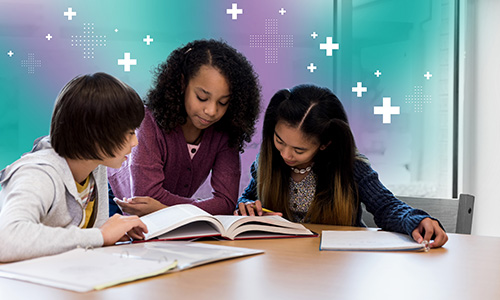
Who says the science of reading is only for reading teachers? Not me, that’s for sure. When it comes to supporting reading fluency and comprehension, there’s a lot that teachers of content like social studies and science can—and should—support as kids work with text. We’re all on the hook.
In my posts on the science of reading, I have recapped what converging evidence tells us about what matters and what works in particular areas of literacy instruction, such as learning to read. How can we support early word recognition? How can we support oral language comprehension? These two big-bucket factors are critical for early readers because they drive an important model: the Simple View of Reading. It says that reading comprehension can be understood, simply speaking, as the product of decoding (word recognition) and language comprehension skills. Decoding (word recognition) is the ability to translate written text into spoken words, while language comprehension is the ability to understand and interpret the meaning of written or spoken language. These two components work together to enable effective reading.
But we have not always focused in on a critical piece of how efficient decoding (word recognition) and language comprehension join together in reading for meaning: the development of reading fluency. In this post, I’ll dig in on fluency and how it supports reading comprehension.
What is reading fluency?
When a student shows strong fluency in a text, we hear smooth and accurate reading that has both a pace and a level of expression that sound a lot like natural speech. Fluency centers on two important factors—automaticity and prosody—and both matter for reading comprehension.
The first half of reading fluency: Automaticity
Many of us think of words correct per minute (WCPM) as a gauge of oral reading fluency. More precisely, that metric captures automaticity in word recognition.
When students read words automatically, that means they recognize the words both accurately and instantaneously. When some of the words are not yet automatic, those words need to be decoded effortfully. That means readers must consciously identify the sounds associated with letters and blend them together to read the words correctly. And that slows kids down. A host of research shows that lower WCPM corresponds to weaker comprehension. That’s because effortful word decoding pulls mental attention, making it hard to attend to meaning at the same time. Recognizing words automatically—reading with automaticity—frees up brain space.
The goal is not reading faster and faster; the goal is moving more words into the automatically recognized category, to enable a focus on comprehension.
How do we help? There are two main components to supporting word recognition. First, we need to help kids sound out unknown words with effective skills; that’s phonics. Next, we need to help them map those words that they have sounded out into memory, moving those words into the automatically recognized category. That process is called orthographic mapping.
How can all teachers build students’ automaticity?
Making words “decodable” means good phonics instruction. But next, we need to give kids a chance to move words from “decodable” into “automatically recognized.”
Research evidence tells us that both reading a correct word aloud and accumulating multiple exposures to a word are likely to help move words into memory so readers can recognize them automatically in future readings. As teachers, we can model the correct decoding of words that students have a hard time with, then ask them to read the word aloud for themselves. We can do this across whole sentences and whole paragraphs: I read, then you read. That’s sometimes called guided repeated oral reading. Then we can move into student-owned repeated readings, including partner reading and choral reading. With partner reading, two students take turns reading aloud to each other, giving feedback (and support!). With choral reading, a group of students reads a text aloud together in unison. Both methods help readers build fluency and comprehension, which can lead to greater confidence, too.
Taking time to read a challenging text several times is supportive of building automaticity with the words in that text. And—better yet—gains in automaticity transfer even beyond that particular text, to other texts. So reading one text over and over makes it easier for kids to read a new text for the very first time.
What about in older grades? Students often tackle difficult text while learning new content, including in social studies and science class. Teachers can introduce a challenging word, model it, and talk through its parts. “That word is photosynthesis. What other words do we know with –photo-? What do you think the root word -photo- means?”
After taking time to model and unpack words, teachers can turn toward practice with reading the sentences that include them. Even in content area instruction, many secondary students who need extra support with comprehension need support in their understanding of and automaticity with hard words.
The second half: Prosody
While automaticity is about recognizing each word, prosody is about interpretive reading of phrases and sentences and paragraphs. We can check automaticity using lists of words, but prosody can only be demonstrated with connected text that is supposed to mean something.
Part of reading passages with fluency involves communicating that meaning, both to others and to ourselves. That has everything to do with our expression: think intonation, phrasing, and pacing. That’s prosody. Once students can recognize the words in a text, they need to support their comprehension by using phrasing, emphasizing particular words, and pausing appropriately to convey meaning. While we can hear prosody when students read orally, it turns out that good prosody is at work supporting comprehension in silent reading, too.
How can we help? Happily, the same basic practices of assisted reading and repeated reading help students develop not just automaticity, but prosody. As the words become more automatic, students can shift focus to interpretive phrasing.
How can all teachers build students’ prosody?
When students are tasked with conveying the meaning of a text to someone else, they have a reason to read with good phrasing and expression. Ask students to prepare a reading of a piece that lends itself to performance, like an important historical speech, a poem, or a play. These require that students get ready by doing multiple readings of the text. They invite students to infuse the reading with expression.
Second, we can teach students that, sometimes, good readers slow down and lean more heavily on prosody as a way to maximize comprehension. This works when you read a meaty sentence and notice at the end of it that you didn’t understand what it said. Secondary teachers, I’m looking at you with your dense content-area texts. Show students how to tune their prosody high and their rate a bit lower when rereading a sentence for understanding.
Reading comprehension: The point of it all
When students can read a text with good accuracy and rate and they can interpret phrasing in ways that support meaning, are they doing deep reading comprehension? Not necessarily. Fluent reading—automaticity and prosody—is supportive of engagement with meaning, but kids need instruction targeted toward maximizing text comprehension, too.
The science of reading comprehension offers several instructional approaches that converging evidence shows to be highly effective. Using the What Works Clearinghouse Practice Guide (and this overview video!), take on each of these two high-leverage topics with your science of reading learning buddies:
- Teach text structures so that students can organize relationships between ideas, including by using graphic organizers. Informational texts in science and social studies are especially supported by work with text structure.
- Model and teach cognitive strategies like self-monitoring for meaning. Can students learn to ask and answer a question for themselves about the text, after each paragraph or two? Check out the older grades’ guidance on this topic, too.
Use scaffolding to improve equity
As we talk about reading comprehension, it is critical that we understand something the science of reading does notsupport: dropping the difficulty of text down to students’ “instructional” reading level for comprehension instruction. Equity in literacy instruction means that we give access to rich, grade-level text to all, including students who need more scaffolding and support to engage with that challenging text.
What’s a key approach to scaffolding that our converging research evidence shows to work? You probably saw this coming. It’s fluency work, including repeated readings of that challenging text.
Good fluency practices build automaticity and prosody. But they also build access to the kind of rich, challenging text that all students need to engage with to grow their comprehension. I’m looking at you, too, middle and high school social studies and science teachers. If we want all students to learn content, then we need to use evidence-based practices that give access to text.




